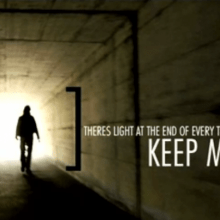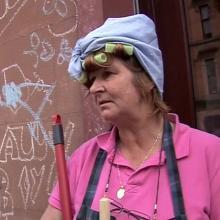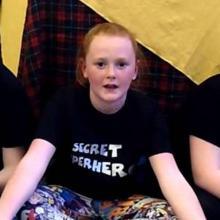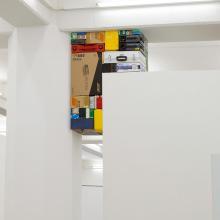Angus Council Day Opportunities team provides weekly visual art sessions as part of the service provision for adults with learning disabilities. The groups were established 10 years ago and artists meet and work in a local church hall in Montrose and studio space at the local theatre in Arbroath. The sessions are led by a qualified arts worker and supported by day opportunity and resource centre staff.
Funding
The art group is funded by the day opportunities team within Angus Council. The participants also pay £5 a week to support the purchase of materials.
Who runs it?
pARTicipate was set up to enable adults with a learning disability who have an interest in the visual arts and who wish to take the opportunity to develop this in a dedicated arts environment with the support of professional artists. There is an art facilitator who leads both groups and sessions are also supported by Angus Council staff and volunteers.
Who are the key partners?
Partnership work is a key strength and the group recently held an open and preview event, at Darlings ENABLE Scotland’s new café, in Arbroath to promote their art work. 21 paintings were sold and another event is planned for later in the year.
Similarly, project coordinators were aware that artists and volunteers often had limited experience of working with individuals with a learning disability. In conjunction with Duncan of Jordanstone college of Art, students were invited to come and work with the artists in the Arbroath group as part of their fourth year course.
How do people hear about it?
The participants who access the groups are adults with learning disabilities from across Angus including the three main towns of; Arbroath, Montrose and Forfar. Most of the artists access the group through the community based day opportunities team with a small number receiving support from a resource centre.
Which art forms do you use?
pARTicipate primarily uses visual arts methods.
In 2001 staff and learning disabled artists from Angus took part in a two week summer school within the visual research centre at Dundee contemporary arts centre. The workshops leaders were professional artists with learning disabilities from Europe and the project brought together artists from Stirling, Fife, Dundee and Angus. The summer school was an opportunity for artists to access state of the art resources in an inclusive environment. Following an evaluation of the project it was established that artists wanted to continue to develop their skills, as well as exhibit and sell their work.
Over the years the group have also participated in more intense week long workshops of photography, ceramic and painting at the local college and Hospitalfield House art studios in Arbroath (an historic and long established arts venue).
What are the outcomes?
Angus Council’s learning disability service has established key outcomes based on the community care outcomes framework and have developed an operational lifestyle tool to record and measure individual outcomes.
Overall, pARTicipate increases opportunities for people who use services to be part of their local community and enjoy a full range of social relationships and be valued members of society, i.e. they are
- supported to take part in leisure and recreation activities
- supported to try new things
The groups provide opportunities for individuals/artists to:
- Increase their sense of well being, confidence and independence by developing their skills and interest in visual arts
- Meet others with an interest in art and develop their art skills
- Take part in exhibitions and competitions and have their work recognised and sold
What are the challenges?
Suitable spaces:
Finding suitable venues for artists to meet and work is a challenge as Angus does not have designated studio spaces for artists and the groups have to clear their work away each week as spaces are shared with other community groups.
Sale of work:
Although now resolved setting up and coordinating the sale of art work was challenging. The group now have a ring fenced account within the council with 60% of the sale of the art work going to the artist and 40% being used to enable the group to purchase framing, materials and marketing for exhibitions.
How do you evaluate?
Work is evaluated on an ongoing weekly basis by individuals in discussions with the arts facilitator. The group also have informal meetings to discuss how to progress and develop the work and the sessions. Meetings are also held between the day opportunities coordinator, the arts facilitator and staff on a regular basis. In addition planning meetings are held when coordinating and organising exhibitions. Comments books are also used at exhibitions.
What are the key characteristics of effective practice?
Challenging preconceptions
Many of the artists have been involved in projects and collaborations locally, nationally and internationally and have shown their work in a number of exhibitions. This in turn has increased awareness of parents/carers and the wider public of the artistic talent within the pARTicipate groups.
Doing with, not to
Opportunities to work with professional artists is a strength of the group and other professional artists have visited, led workshops and exhibited alongside pARTicipate artists. Arts facilitators have commented that they enjoyed the interactions with the groups and seeing each person develop their own unique artistic style.
Recommendations / Opportunities and Outcomes
- The opportunity to exhibit and sell art work is a key motivator for the artists. For example, the Meffan exhibition is an incredibly difficult exhibition to get into where artists submit anonymously and each piece is accepted on its merit. Two of the artists have been chosen to exhibit and their work was considered no different from others. This was a huge success for the individuals and also had a positive impact on the group.
- Having professional artists work alongside the artists encouraging mutual experience of skills is particularly important.
- Arts facilitator making space and time to nurture their own creativity. This is useful in bringing fresh and new ideas, methods and processes to each group to continue to push the group on.
- The importance of the social aspect of the group. Art is a useful opportunity for people to meet people and make connections.
Further information
For further information please contact:
Ali Kennedy, Day Opportunities Coordinator, Angus Council
akennedy@angus.gov.uk 01241 438051




